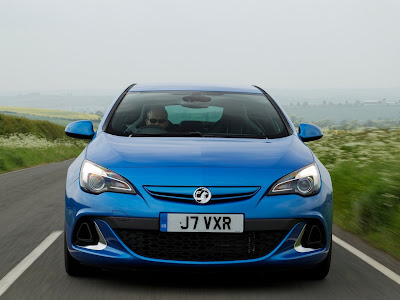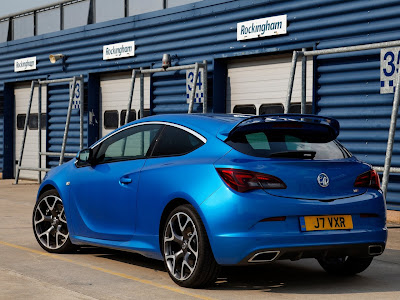The centre-piece of the Vauxhall Astra VXR’s cabin is Vauxhall’s all-new flat bottom steering wheel. Its diameter has been reduced from 370mm to 360mm compared with all other models in the Astra range, making the steering feel even more precise and direct. The handwheel’s grip has been enhanced by packing supple sponge rubber around a magnesium/steel hybrid ring and then covering the entire wheel in premium, soft cross-stitched leather. The wheel is available with an optional heated rim, and features the VXR logo, as well as multi-function controls on its spokes.
While the Vauxhall Astra VXR is based on the new GTC, it has benefitted from a raft of bespoke chassis modifications to cater for the significant boost in performance brought by the 2.0-litre turbocharged engine, which produces 280PS and 400Nm of torque.
2013 Vauxhall Astra VXR
Further changes to the chassis include brakes developed by competition supplier, Brembo, standard fitment of Vauxhall’s fully adaptive FlexRide damping system, uprated springs and new dampers developed between VXR and ZF Sachs.
Vauxhall’s new Astra VXR will incorporate deliver a class-leading 400Nm of torque, giving it a 0-60mph time of 5.9 seconds and robust mid-range performance.
The VXR’s turbocharged, 2.0-litre direct-injection engine harks from the Insignia family, but while its aluminium block is similar, the VXR has a unique aluminium cylinder head and new turbocharger to liberate 280PS (up 40PS on the previous model) and over 200Nm per litre of torque – the highest specific output in its class.
Developing a high-torque engine for the Vauxhall Astra VXR was the key to unlocking the car’s real-world, mid-range performance, rather than focusing on power alone. And with maximum torque produced on a broad plateau between 2450rpm and 5000rpm, VXR drivers will never want for instant acceleration.
An all-new, state-of-the-art intake system was developed to feed as much air into the turbocharger as possible. The turbocharger itself was also improved to take more charge-air pressure, which builds from as early as 1400rpm for linear and strong acceleration. The maximum charge pressure is now 1.5 bar – 25 per cent more than in the Insignia 2.0T.
Vauxhall Astra VXR drivers can also look forward to a soundtrack that has been carefully engineered to appeal to enthusiasts, both from inside and outside the car. Drivers will get the full effect in the mid-to high rev range, especially when they change up from third to fourth under full throttle.
But outright performance hasn’t come at the expense of efficiency and durability. Like all recent VXR models, the Astra was subjected to prolonged testing at the Nüburgring’s notorious Nordschleife for 10,000 kilometres under race conditions – the equivalent to around 110,000 road miles.
And while the Astra VXR can accelerate from 0-60mph in just 5.9 seconds and hit a maximum 155mph, standard Start/Stop technology has reduced fuel consumption by 14 per cent (compared with the previous model) to a combined 34.9mpg, and reduced emissions to 189g/km.










No comments:
Post a Comment